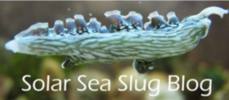Monthly Archives: April 2016


We Have Data!
It has definitely been a good week for the Solar Slug Project. Yesterday, all of the pieces for the barcoding project started to fall into place. As I described a few weeks ago, the idea is to use a sensitive method called polymerase chain reaction (PCR) to amplify DNA from chloroplasts within the slugs in order to figure out what they have been eating. Our first step was to extract and amplify DNA from potential food plants, just to be certain everything was working. Below, you can see Maryam and Haseeb, the two USG students who have been working on this project, diligently extracting DNA from Halimeda and Bryopsis samples.
After a few false starts, we got conditions to the point that everything appears to be working. One key change was switching to GE Healthcare’s “Ready-To-Go” beads as the source of polymerase, buffers, nucleotides, etc. The beads can be stored at room temperature (as opposed to being frozen, like other “master mixes”), which will make life a lot easier at the field station.
The PCR products are the right size (about 600 base pairs), and there aren’t any extra bands. We used primers specific to Halimeda discoidea (“H primers”) for the products in the first four lanes, and primers for Bryopsis plumosa (“B primers”) for the last four. The species names, “Halimeda 1″ etc, indicate the following species:
Halimeda 1 (Presumed H. discoidea).
The specimen of Halimeda 2 (H. incrassata) was a bit bleached, but yielded some nice DNA
Bryopsis “species 1” has a much finer structure.
Bryopsis 2 is stouter and longer. It is unlikely to be a different growth form of the same species, because they were cultured right next to each other. It’s a good opportunity to let the gene sequences unravel who’s who.
The astute observer will notice that we got products from (almost) all species using both sets of primers. Overall, that’s a good thing, in that we can use these primers to amplify DNA from many species of algae, then submit the DNA for sequencing. On the other hand, we could use more stringent conditions (like a higher annealing temperature, for those who care about such details) to use primers to amplify DNA only from a particular species. For example, we could use Bryopsis primers on DNA extracted from slugs to ask specifically whether the animals contain Bryopsis DNA.
The quick summary is that we have worked out the details of methods needed to extract, amplify, and ultimately sequence DNA from chloroplasts. Haseeb and Maryam will be able to put together some nice reports about their work, and in Bahia de los Angeles this summer, we should be able to determine the species of algae that E. diomedea eats.
Pig-Out Time
In the “one reefer’s pestilence is a slug’s tasty snack” department, Marcos from Exotic Reef Creations sent over a batch of rock and zoanthids and live rock that were covered with lush Bryopsis growth. Although the dedicated algae tanks have helped keep the supply up, I was very excited to receive the new infusion. The gals are over the moon about it. The photos below show the whole gang hunkered down in feeding posture. They have been face down in it for almost 24 hours now.
The goal is to have them clear the algae so the corals can go back home. It will be interesting to see how long that takes.
Meantime, the molecular experiments are moving along. More soon.









Recent Comments